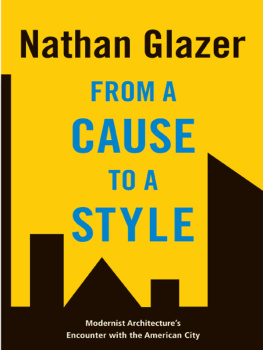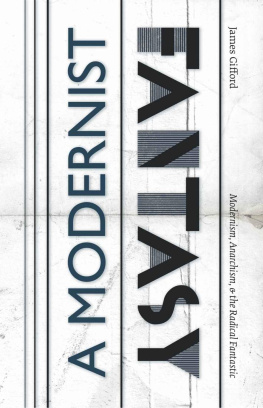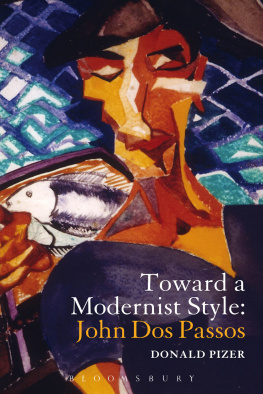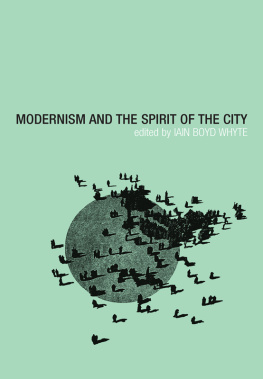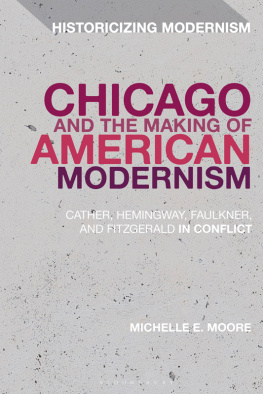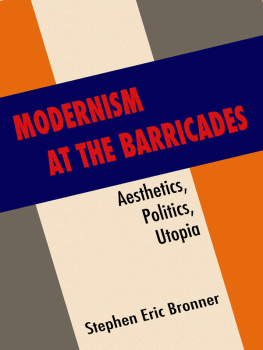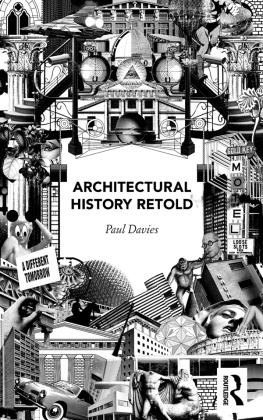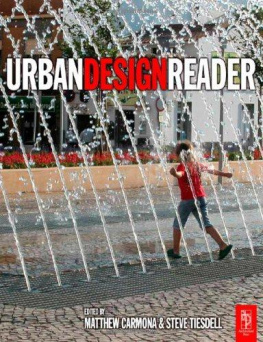FROM A CAUSE TO A STYLE
Also by Nathan Glazer
The Lonely Crowd (with David Riesman and Reuel Denney)
Faces in the Crowd (with David Riesman)
American Judaism
The Social Basis of American Communism
Beyond the Melting Pot (with Daniel P. Moynihan)
Remembering the Answers:Essays on the American Student Revolt
Affirmative Discrimination:Ethnic Inequality and Public Policy
Ethnic Dilemmas, 19651982
Clamor at the Gates: The New American Immigration (editor)
The Public Face of Architecture (editor, with Mark Lilla)
The Limits of Social Policy
Conflicting Images: India and the United States (editor, with Sulochana Raghavan Glazer)
We Are All Multiculturalists Now
Sovereignty under Challenge: How Governments Respond (editor, with John D. Montgomery)
FROM A CAUSE TO A STYLE
Modernist Architecture's Encounter
with the American City
NATHAN GLAZER
Princeton University Press
Princeton and Oxford
Copyright 2007 by Princeton University Press
Published by Princeton University Press, 41 William Street,
Princeton, New Jersey 08540
In the United Kingdom: Princeton University Press,
3 Market Place, Woodstock,
Oxfordshire OX20 1SY
All Rights Reserved
Library of Congress Cataloging-in-Publication Data
Glazer, Nathan.
From a cause to a style : modernist architecture's encounter
with the American city / Nathan Glazer.
p.cm.
Includes bibliographical references and index.
ISBN-13: 978-0-691-12957-0 (hardcover : alk. paper)
ISBN-10: 0-691-12957-6 (hardcover : alk. paper)
1. Architecture and societyUnited StatesHistory20th century.
2. City planningUnited StatesHistory20th century. 3. City
planningSocial aspectsUnited States. 4. Modernism
(Aesthetics)United StatesHistory20th century. I. Title.
NA2543.S6G59 2007
720.973'0904dc222006028071
British Library Cataloging-in-Publication Data is available
This book has been composed in Mridien with Frutiger Display
Printed on acid-free paper. 
press.princeton.edu
Printed in the United State of America
10 9 8 7 6 5 4 3 2 1
Contents
Many of these essays have been previously published, but all have been edited and revised, and some have been substantially rewritten, and appear in a form quite different from the original place of publication. Chapter 1 was presented as a paper in the Boston, Melbourne, Oxford Conversazione on "The Public Face of Architecture" in 1991, was published in their proceedings, edited by Claudio Veliz, and also published in the Australian journal Quadrant (December 1991). Chapter 2 was published in The American Scholar (Autumn 1990).Chapter 3 was delivered as the Benjamin C. Howland lecture at the University of Virginia, and published in ThePublic Interest (Fall 1992). Chapter 4 was presented in the Boston, Melbourne, Oxford Conversazione on "Monuments for a World without Heroes, " 1995, published in the proceedings of the Conversazione, edited by Claudio Veliz, and also in The Public Interest (Spring 1996). A different version of chapter 5 appears in The Mall and theNation, edited by Nathan Glazer and Cynthia Field (Baltimore: Johns Hopkins University Press, 2007). This paper was commissioned by the Newington-Cropsey Cultural Studies Center, which also funded the research for it.Chapter 6 appeared in Celebrating the Courthouse, edited by Steven Flanders (New York: W. W. Norton, 2006).Chapter 7 was published in City Journal (Autumn 1991).Sections of chapter 8 have appeared in the American ArtsQuarterly (Summer 2002); City Journal (Winter 1995); ThePublic Interest (Fall 1996). Chapter 9 was published inCity Journal (Spring 1992). Chapter 10 appeared in TheProfession of City Planning, edited by Lloyd Rodwin and Bishwapriya Sanyal (New Brunswick, N.J.: Center for Urban Policy Research, Rutgers University, 2000). Chapter 11 was presented at Princeton University at a conference in honor of Robert Gutman, and has not been previously published.
Iwould like to expressmy appreciation to TimSullivan, my editor at Princeton University Press, who saw the possibilities of this book, and shepherded it through the various stages leading to publication with rare understanding and imagination; to Lauren Lepow, at Princeton University Press, who gave the manuscript a meticulous reading and has helped to improve it; and to Sulochana Raghavan Glazer, my wife, who read the manuscript closely twice with sustained enthusiasm, discovered errors and inconsistencies, and proposed changes that helped make it a better book.
FROM A CAUSE TO A STYLE
In the 1980s, the Prince of Wales, who has adopted a number of surprising causes for a prince in the course of his life, became for a time the most influential critic of architecture, urban design, and planning in Great Britain.Both modernist architecture and modernist city planning had been very successful in Britainas indeed they have been almost everywherein shaping new towns and rebuilding the centers of old cities and towns. But ordinary people often looked on the results with dismay. The prince's interventions and criticisms received wide publicity, and were effective in derailing some high-profile projects by modernist architects.
Leading architects, who by the end of World War II had pretty much been fully captured by modernism in architecture and urban design and planning, were outraged by the prince's unprofessional intervention in their work and practice. They had been criticized before; but never by someone whose comments had such resonance in the public media.
The architects, to their disgruntlement, were portrayed as arrogant, unresponsive to what ordinary people wanted, indifferent to their interests, as they pursuedtheir own visions as to what was appropriate and suitably contemporary or advanced in the design of major structures and in the shaping of town and city. Ordinary people, it seems, endorsed the prince's taste for more traditional features in major public buildings and more traditional layouts of towns and cities.
But what was most shocking to modernist architects was how easy it was to portray them as distant from the people and their interests. For at the origins of modernism in architecture and urban design and planning, the visionary architects and planners were, in their minds, leagued with the people against what they saw as archaic, overblown, extravagant, and inefficient architecture and design, the taste of princes. Some of the architects who launched modernism were socialists, close to the movements of the working class. Modernism in architecture and planning spoke for the people and their interestsin good sanitary housing, in green space, in access to air and light, in more living space, in an urban environment adapted to their needs and interestsand against the interests of princes, or merchant princes, or profit-minded developers. Modernism, in its origins, was a cause, not simply another turn in taste. What, then, had happened, that a prince could better represent the people, their interests and tastes, than the architects?
Something odd and unexpected seems to have happened to modernism in architecture and planning: it had broken free from its origins and moorings, drifted away from the world of everyday life, which it had hoped to improve, into a world of its own. From a cause that intended to remake the world, it had become a style, ora family of styles. Modernism had, it is true, produced masterpieces, but it had been incapable of matching the complex urbanity that the history of building, despite its attachment to the historical styles decried by modernism, had been able to create in so many cities. As the older parts of cities were swept away in a wave of urban renewal, as nineteenth-century courthouses and city halls were demolished for modern replacements, more and more people wondered whether what they had lost was matched by the new world being created by modernism.The essays collected in this book reflect the growing disenchantment of an early enthusiast of modernism in architecture and planningand who when young is not?with the failures of modernist architects and planners in dealing with contemporary urban life. Of course it is giving architects too much power, too much credit, to ascribe the ills of urban life to them; architects are only one player in shaping urban life. What becomes of our cities is a matter that in varying degrees involves us all: developers, elected officials, government agencies, the variety of interest groups among "the people" and what they will tolerate or protest in urban development.
Next page
